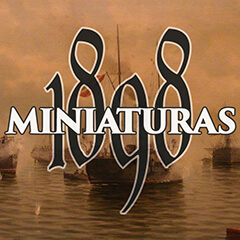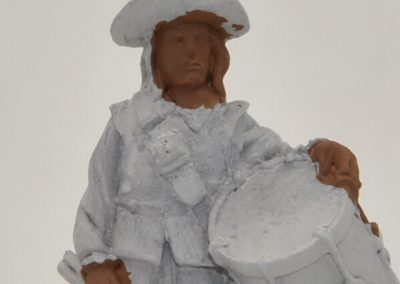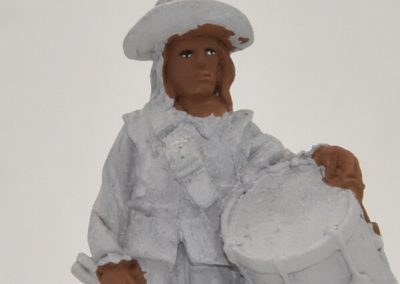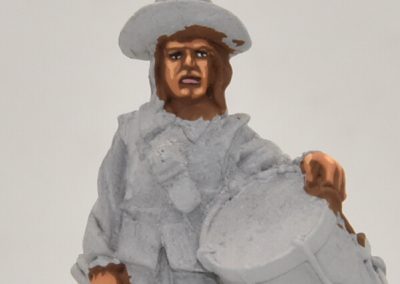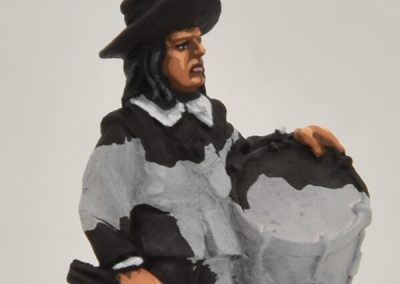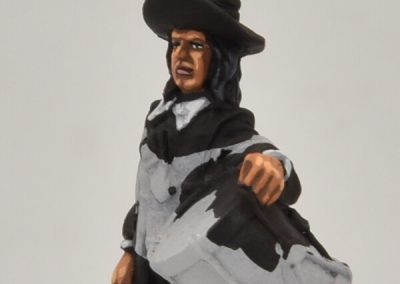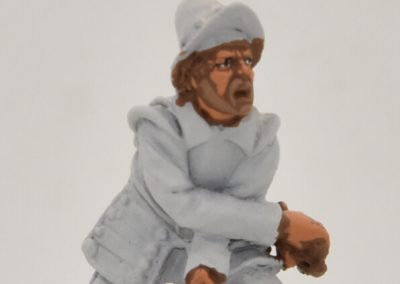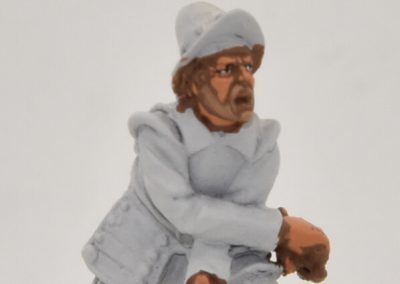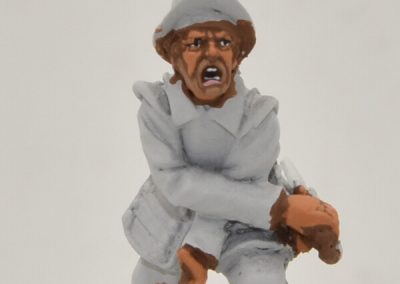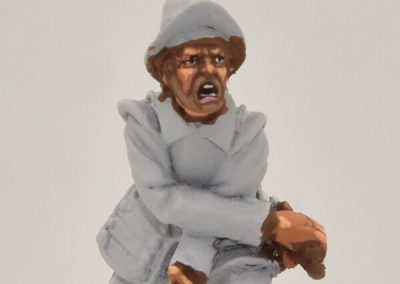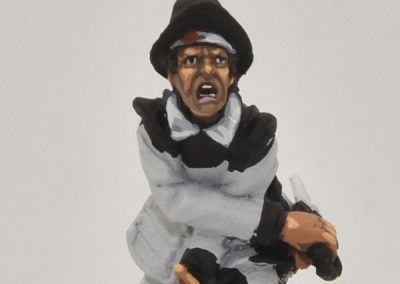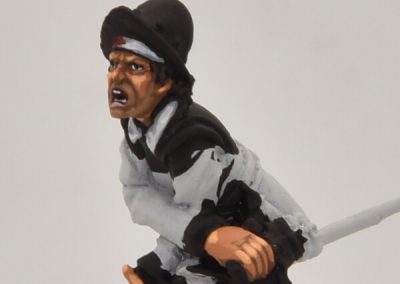How to paint faces in 28 mm
Javier Gómez "El Mercenario"
1898 Miniaturas

Painting faces is one of the most demanding experiences in the painting process of any 28mm miniature, but also one of the most rewarding. Faces are one of the most important parts of miniatures, and without a doubt the trait that gives them more life, personality and character. And if there is something that characterizes the figures of 1898 Miniatures, it is precisely their character. Therefore, I propose you some ideas with which we can paint faces in 28 mm in a simple way, making the most of them in this article that inaugurates a trilogy that we will complete with How to paint eyes in 28 mm and How to paint different skin tones in 28 mm.
MATERIALS
For this tutorial we will use different figures from the 1898 Miniatures’s range of Spanish Tercios for the Thirty Years’ War, Vallejo Model Color paintings (three-digit numerical references, eg 863, for options of other brands, consult this color chart) as well as primer spray of any brand (although I always recommend Citadel’s).
PREPARATION AND ASSEMBY
Firstly, although the 1898 Miniaturas’s figures come extremely clean of burrs, with our modeling knife we will clean all kinds of metal surpluses, and we will glue the swords with cyanoacrylate in their corresponding place. Regarding pikemen, it is up to you whether to glue the pike before painting, which can be annoying, or after, once painted (although we will have to be very careful with the glue). Finally, we will glue the miniature with cyanoacrylate on an empty paint bottle to handle the figure at will during the painting process without having to touch it, and we will prime the figure with a very thin layer of white spray. Normally we would repaint the miniature in black, as we have seen in previous articles, but for this tutorial we will leave it white.
GENERAL TECHNIQUE
To paint faces in 28 mm we will use the traditional system of base color and two highlights, explained in other painting articles on the website of 1898 Miniatures, ignoring for the moment the black base. Throughout this article we will paint three different types of faces with different features, that of a young drum, that of a seasoned veteran and that of an elderly captain. Regardless of the differences that we will explain below, in all three we will use the same color schemes and follow the same step by step sequence:
- Step 1: Base color of face and hands
- Step 2: Eyes
- Step 3: 1st light of the face and hands
- Step 4: Beard shadow, if applicable, 1st and 2nd light
- Step 5: Mouth (first we will paint the line or interior, then the lower lip and finally the teeth, if applicable)
- Step 6: 2nd light of the face and hands
- Step 7: Hair and facial hair (we will take advantage to correct possible mistakes)
When it comes to painting faces in 28 mm we can vary greatly the way of painting the same face, from the attitude of the eyes to the expression of the nose, the shape of the upper lip or chin, the volume of wrinkles, the 5 o’clock shadows and, of course, hair color, to the point of making the same figure look totally different. As a general rule, the fewer strokes we give to the face, the more youthful will be its appearance, and the more strokes, the more veteran.
Drummer of the Tercios
We will start with a young drummer, whose fresh and beardless face does not yet reflect the rigors of life on campaign (and of syphilis). Therefore, we will paint slightly marked features, but we will allow ourselves the license to paint split both the upper lip and the chin to give it a little character. The lip lines meet the cheeks, enhancing her youthful appearance. In the eye area we will only paint the upper eyelids, and we will avoid eye bags. The nose with a single stroke and the smooth forehead, in a relaxed attitude. Normally we will paint the hair with a single highlight, but in this case, when taking it so long, we will apply two highlights to it.
Veteran pikemen
This soldier, on the other hand, already carries some campaigns behind him. We will paint bags on his eyes, a wrinkled nose and a frown, as well as a prominent beard of several days. These prominent 5 o’clock shadows look best on figures with dark hair. In his case, the lines of the lips do not meet the cheeks, which indicates more marked features. Unlike the drummer, the upper lip is more continuous and the chin has been painted in a rounded shape. When painting the upper eyelids we accidentally invaded the black line of his right eye that simulates the eyelashes, which we will take advantage of to correct at the end, when we paint the hair.
Captain
The face of this officer carries a greater number of strokes, both in the first and in the second light, which shows deeper wrinkles. To highlight the most marked brushstrokes around the eyes, on the nose and between the eyebrows. His seniority is also reflected in his chestnut beard, which we have provided with two good strands of gray hairs on both sides.
Colour schemes
| TO PAINT | BASE COLOR | 1st HIGHLIGHT | 2nd HIGHLIGHT |
| Skin | Beige Brown (875) | Light Brown (929) + Sunny Skin Tone (845) | Sunny Skin Tone (845) |
| Eyes | White (951) | Black (950) | |
| 5 o’clock shadows | Beige Brown (875) | Beige Brown (875) + Sunny Skin Tone (845) | 1st highlight + Sunny Skin Tone (845) |
| Mouth | Hull Red (985) | ||
| Lower lip | Old Rose (944) | ||
| Black hair | Black (950) | Black (950) + Neutral Grey (992) | |
| Dark hair | Black (950) | Chocolate Brown (872) | |
| Brown hair | Chocolate Brown (872) | Beige Brown (875) | |
| Blond hair | Beige Brown (875) | Yellow Ochre (913) | |
| Red hair | Hull Red (985) | Light Brown (929) | |
| Grey hair | Neutral Grey (992) | Sky Grey (989) | |
| White hair | Light Grey (990) | White (951) |
Bibliography
Bru, J. y Claramunt, A. (2020): Los tercios. Madrid: Desperta Ferro Ediciones.
Gómez Valero, J. (2015): Painting Wargame Miniatures. Barnsley: Pen & Sword.


